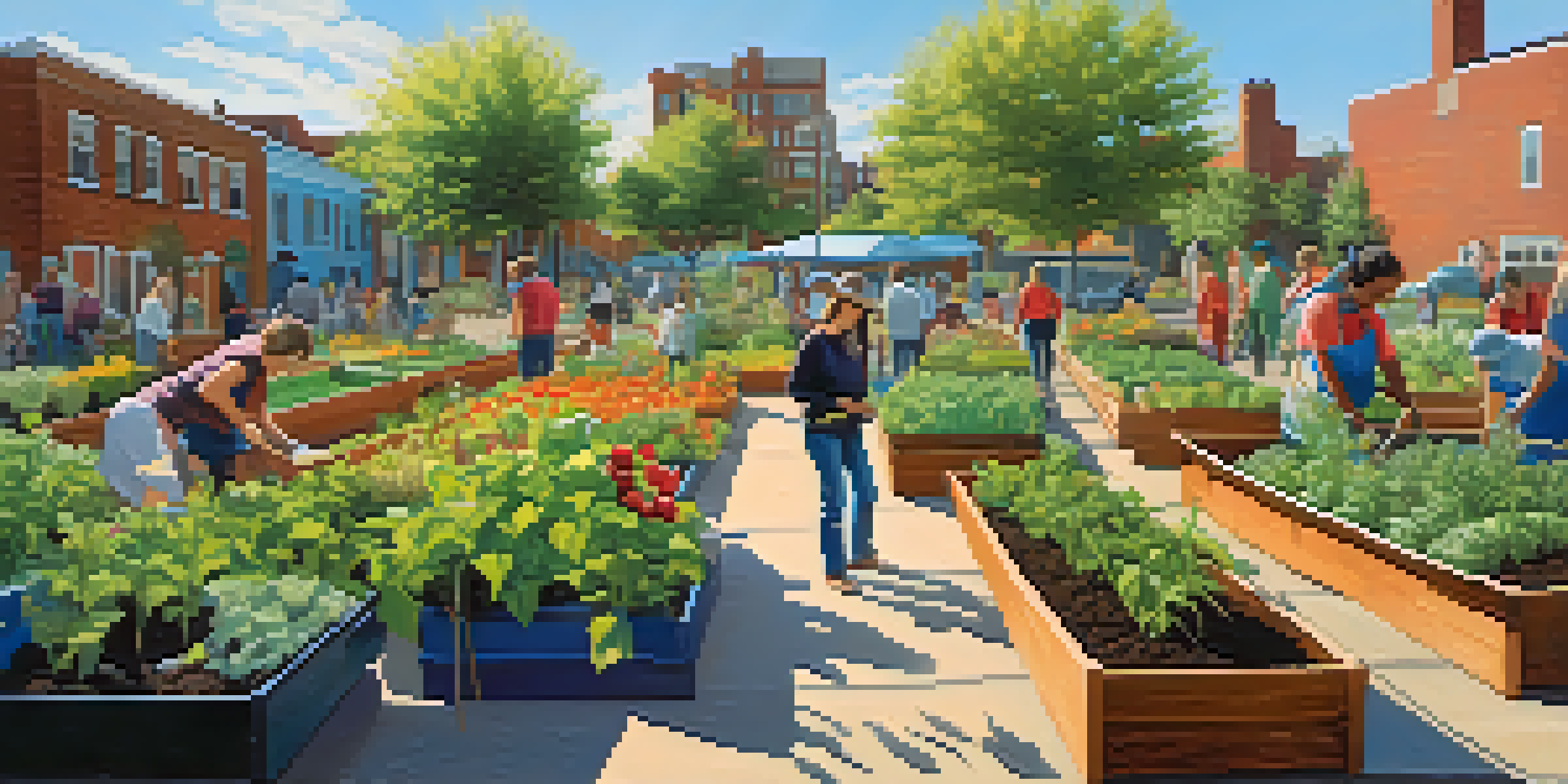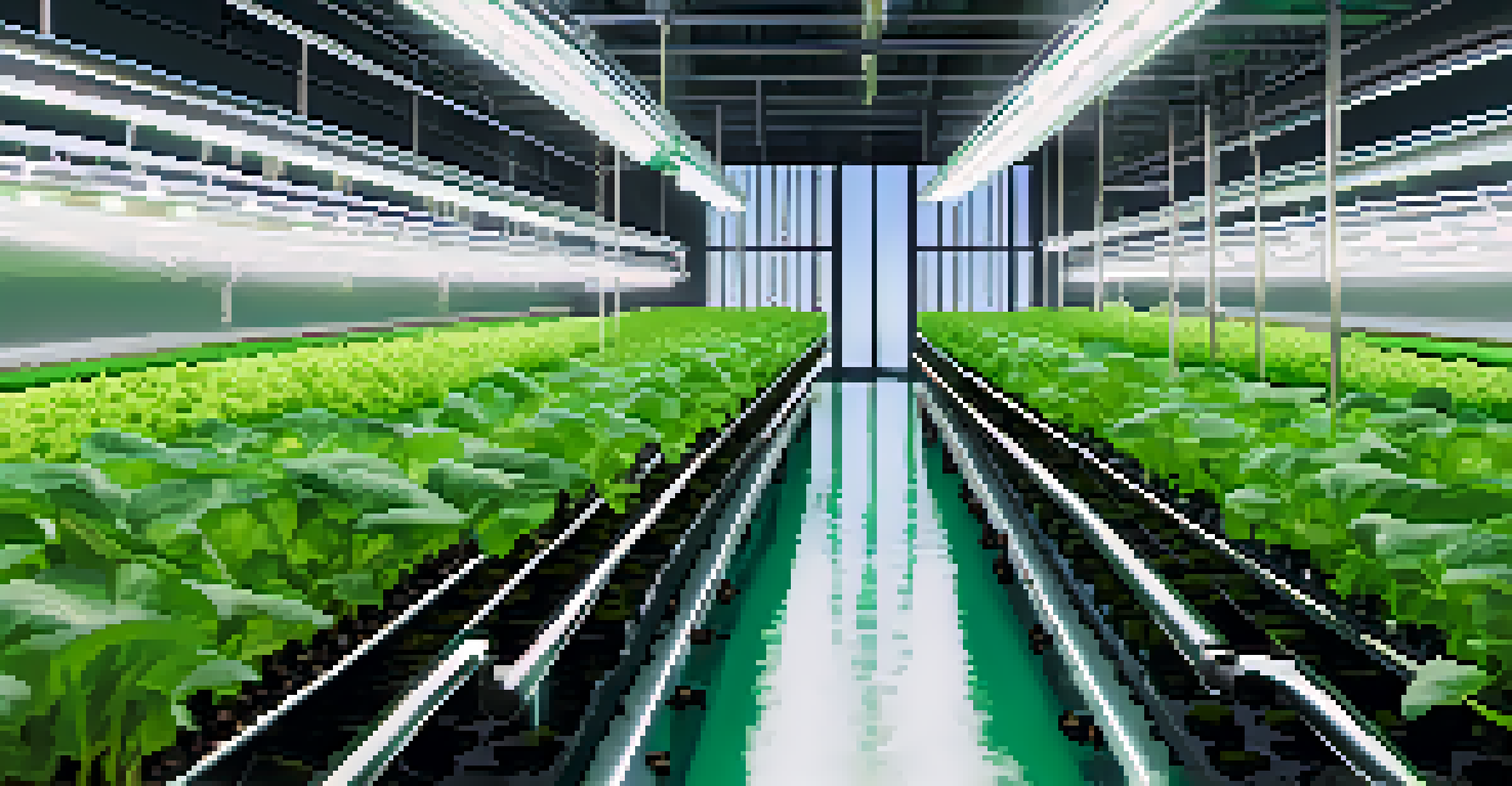Urban Farming: Technology-Driven Solutions for Food Security

Understanding Urban Farming and Its Importance
Urban farming refers to the practice of cultivating, processing, and distributing food in and around urban areas. With cities expanding rapidly, the need for local food production has never been more critical. This practice not only enhances food security but also reduces the carbon footprint associated with transporting food over long distances.
The future will be about urban agriculture, urban farming, and urban design that supports local food systems.
Moreover, urban farming promotes community engagement and education about sustainable practices. It empowers residents to take control of their food sources, leading to healthier lifestyle choices. Just think about how a community garden can transform a vacant lot into a vibrant space for learning and collaboration.
Additionally, urban farms can help mitigate the effects of food deserts—areas with limited access to fresh produce. By integrating farms into cities, we can provide fresh, nutritious food to those who need it most, improving overall public health and wellbeing.
The Role of Technology in Urban Farming
Technology has become a game-changer in urban farming, enabling innovative solutions to age-old problems. From vertical gardens that maximize space to hydroponic systems that conserve water, technology is helping urban farmers grow more with less. These advancements not only optimize resources but also increase crop yields significantly.

Moreover, precision agriculture tools, such as sensors and drones, allow farmers to monitor plant health and soil conditions in real time. Imagine being able to track exactly when a plant needs water or nutrients, ensuring optimal growth without waste. This data-driven approach makes urban farming more efficient and productive.
Urban Farming Boosts Food Security
Urban farming enhances local food production, reduces transportation emissions, and addresses food deserts.
As urban farms embrace technology, they also become more resilient against climate change. By implementing smart technologies, such as climate control systems in greenhouses, farmers can adapt to unpredictable weather patterns, ensuring a reliable food supply even in challenging conditions.
Hydroponics: A Soil-Less Solution for Urban Areas
Hydroponics is a method of growing plants without soil, using nutrient-rich water instead. This technique is especially beneficial in urban environments where space is limited. By stacking layers of crops vertically, urban farmers can cultivate a variety of plants in a smaller footprint than traditional farming methods.
In the end, the more we can create food systems that are resilient, that are local, that are diverse, that are based on the principles of ecology, the better off we will all be.
One of the most appealing aspects of hydroponics is its efficiency. It uses up to 90% less water compared to conventional farming, making it a sustainable choice in water-scarce regions. This is particularly important as cities face growing challenges related to water scarcity and pollution.
Additionally, hydroponics allows for year-round crop production, independent of seasonal changes. Urban farmers can grow fresh produce even during the harshest winters, providing a continuous supply of food to local communities. This stability is crucial for improving food security in urban settings.
Vertical Farming: Maximizing Space in Urban Environments
Vertical farming takes urban agriculture to new heights—literally. By growing crops in vertically stacked layers or integrated into structures, this method optimizes limited urban spaces. It transforms everything from warehouses to rooftops into productive farmland, making it an innovative solution for city dwellers.
This method not only saves space but also enhances resource efficiency. Vertical farms often utilize LED lighting and climate control technologies to create ideal growing conditions. As a result, they can produce crops at a fraction of the energy costs associated with traditional farming.
Technology Enhances Urban Agriculture
Innovations like hydroponics and precision agriculture tools make urban farming more efficient and resilient.
Moreover, vertical farms contribute to air quality improvement by absorbing carbon dioxide and releasing oxygen. By incorporating greenery into urban landscapes, they not only provide food but also enhance the beauty and livability of cities. It's like bringing a slice of nature back to the concrete jungle.
Aquaponics: Integrating Fish and Plant Farming
Aquaponics is an innovative farming method that combines aquaculture (raising fish) with hydroponics (growing plants in water). This symbiotic relationship allows waste from fish to nourish plants, while plants help filter and clean the water for the fish. It creates a sustainable ecosystem that benefits both crops and aquatic life.
In urban settings, aquaponics systems can be set up in small spaces, making them ideal for home gardeners and community farms alike. This method not only produces fresh fish and vegetables but also educates communities about sustainable food production practices. It's a two-for-one deal that promotes biodiversity and responsible farming.
Furthermore, aquaponics systems can be highly efficient, using up to 90% less water than traditional farming. As cities face increasing water shortages, this method presents a viable solution for maintaining food production without straining natural resources.
Community Engagement: Building a Supportive Network
Community engagement is essential for the success of urban farming initiatives. By fostering relationships among local residents, farmers, and organizations, urban farms can create a supportive network that enhances food security. Community involvement ensures that these initiatives reflect the needs and preferences of the people they serve.
Workshops, volunteer days, and farm-to-table events are excellent ways to involve the community in urban farming efforts. These activities not only educate participants about sustainable practices but also build a sense of ownership and pride in local food sources. When people feel connected to their food, they're more likely to support these initiatives.
Community Engagement is Key
Building relationships among residents and farmers strengthens local food initiatives and fosters sustainability.
Additionally, community-supported agriculture (CSA) programs allow members to invest in local farms, receiving fresh produce in return. This mutual support strengthens the local economy and fosters a culture of sustainability. It’s a win-win situation that encourages collaboration and resource sharing among community members.
Challenges and Solutions in Urban Farming
While urban farming presents many opportunities, it also faces unique challenges. Limited space, high startup costs, and regulatory hurdles can deter individuals and organizations from pursuing urban farming projects. Addressing these challenges requires innovative thinking and collaboration among stakeholders.
One potential solution is to promote policies that support urban agriculture, such as zoning changes that allow for farming in residential areas. By creating a favorable regulatory environment, cities can encourage more people to start urban farms. Grants and funding opportunities can also help alleviate financial burdens for aspiring urban farmers.

Education and training programs can further empower individuals to overcome these challenges. By providing access to resources and information, urban farming initiatives can equip aspiring farmers with the skills they need to succeed. Building a strong foundation of knowledge helps ensure the longevity and sustainability of urban farms.